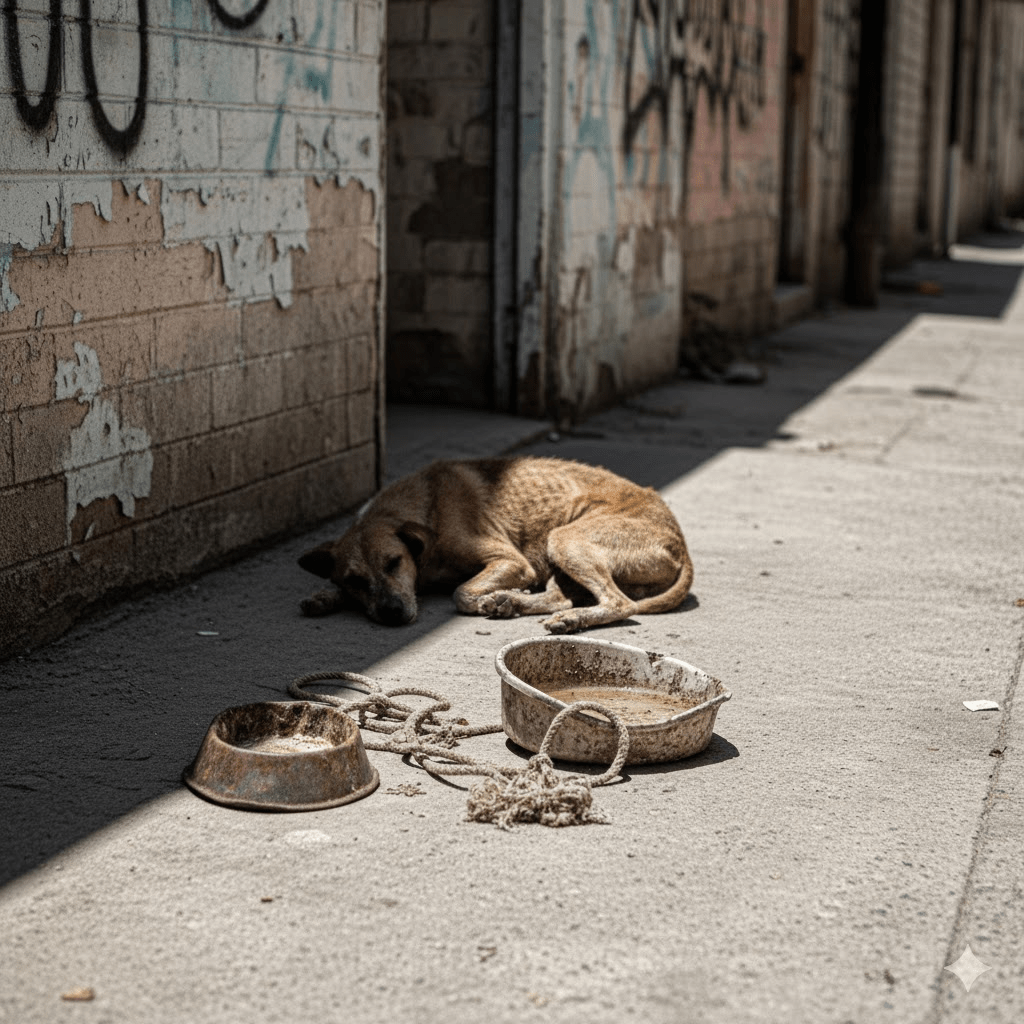The image before us is a stark reminder of a pervasive and deeply troubling issue: animal neglect. It captures a moment of raw vulnerability, depicting a dog in a state of advanced emaciation, its ribs painfully visible beneath a distended abdomen that hints at a heavy parasitic load or perhaps the after-effects of multiple pregnancies without adequate nourishment. The barren, dusty ground it lies upon, devoid of comfort or even a clean place to rest, speaks volumes about its living conditions. A thin, worn collar, possibly once a marker of belonging, now seems a cruel irony, failing to protect or provide for the creature it adorns. Scattered, dry food pellets nearby, perhaps a recent offering, appear untouched or insufficient, highlighting a deeper, systemic failure in care. This single snapshot encapsulates a narrative of prolonged suffering, a silent plea that resonates with the conscience, urging us to look beyond the image itself and delve into the multifaceted reasons behind such neglect and the profound impact it has on the lives of countless animals. It forces us to confront uncomfortable truths about human responsibility and the consequences when that responsibility is abandoned.

Animal neglect is not merely the absence of malice; it is the absence of care, a slow and agonizing form of cruelty that often goes unnoticed or unaddressed until the physical manifestations become undeniable. It encompasses a spectrum of deficiencies, from inadequate nutrition and lack of clean water to insufficient shelter, medical attention, and even basic social interaction. Unlike overt abuse, which involves deliberate harm, neglect is often a byproduct of ignorance, financial hardship, mental health struggles, or a profound lack of empathy on the part of the owner. Understanding this distinction is crucial, as it informs the strategies needed for intervention and prevention. While the immediate focus is always on rescuing the animal, long-term solutions require addressing the root causes that allow such situations to fester.

The visible signs of neglect, as seen in the initial image, are often the most compelling evidence. Emaciation, caused by chronic malnutrition, leaves an animal weak, susceptible to illness, and struggling for survival. Dehydration, another common symptom, can rapidly lead to organ failure and death. Unkempt coats, matted fur, and untreated skin conditions are not just cosmetic issues; they are indicators of discomfort, pain, and a breeding ground for parasites and infections. Overgrown nails can cause debilitating pain and impede movement, while dental disease can make eating excruciating. Beyond the physical, neglected animals often display profound psychological trauma, manifesting as fear, aggression, depression, or an inability to trust. These animals often carry the scars of their past long after their physical wounds have healed.

While the images of suffering are heartbreaking, it is important to remember that rescue and rehabilitation are possible. Animal welfare organizations, often operating with limited resources and dedicated volunteers, play a critical role in intervening in cases of neglect. They provide immediate medical attention, nutritious food, clean water, and safe shelter. Just as crucial is the emotional rehabilitation, helping these animals overcome their fear and learn to trust again. This process can be lengthy and challenging, requiring immense patience and understanding. Success stories, however, are powerful testaments to the resilience of animals and the transformative power of compassionate care, demonstrating that even the most severely neglected can find comfort, love, and a second chance at life.

Recognizing the signs of neglect is the first step in combating this widespread problem. Education is paramount, ensuring that pet owners understand the fundamental requirements for animal welfare. Community outreach programs can provide resources and support to individuals struggling to care for their pets, offering assistance with food, veterinary care, and even temporary shelter during times of crisis. Strengthening animal protection laws and ensuring their rigorous enforcement are also vital. Public awareness campaigns can encourage individuals to report suspected cases of neglect, providing a lifeline for animals who cannot advocate for themselves. By fostering a culture of responsibility and empathy, we can work towards a future where every animal receives the care and respect it deserves.







